If you're looking for a vegan and gluten-free flatbread recipe, then try this Indian roti that's made with a healthy combination of teff flour and rice flour. It's made without xanthan gum, yeast, or psyllium husk. These simple and easy rotis can be made in 30 minutes!
This is a sponsored conversation written by me on behalf of Maskal Teff. The opinions and texts are all mine.
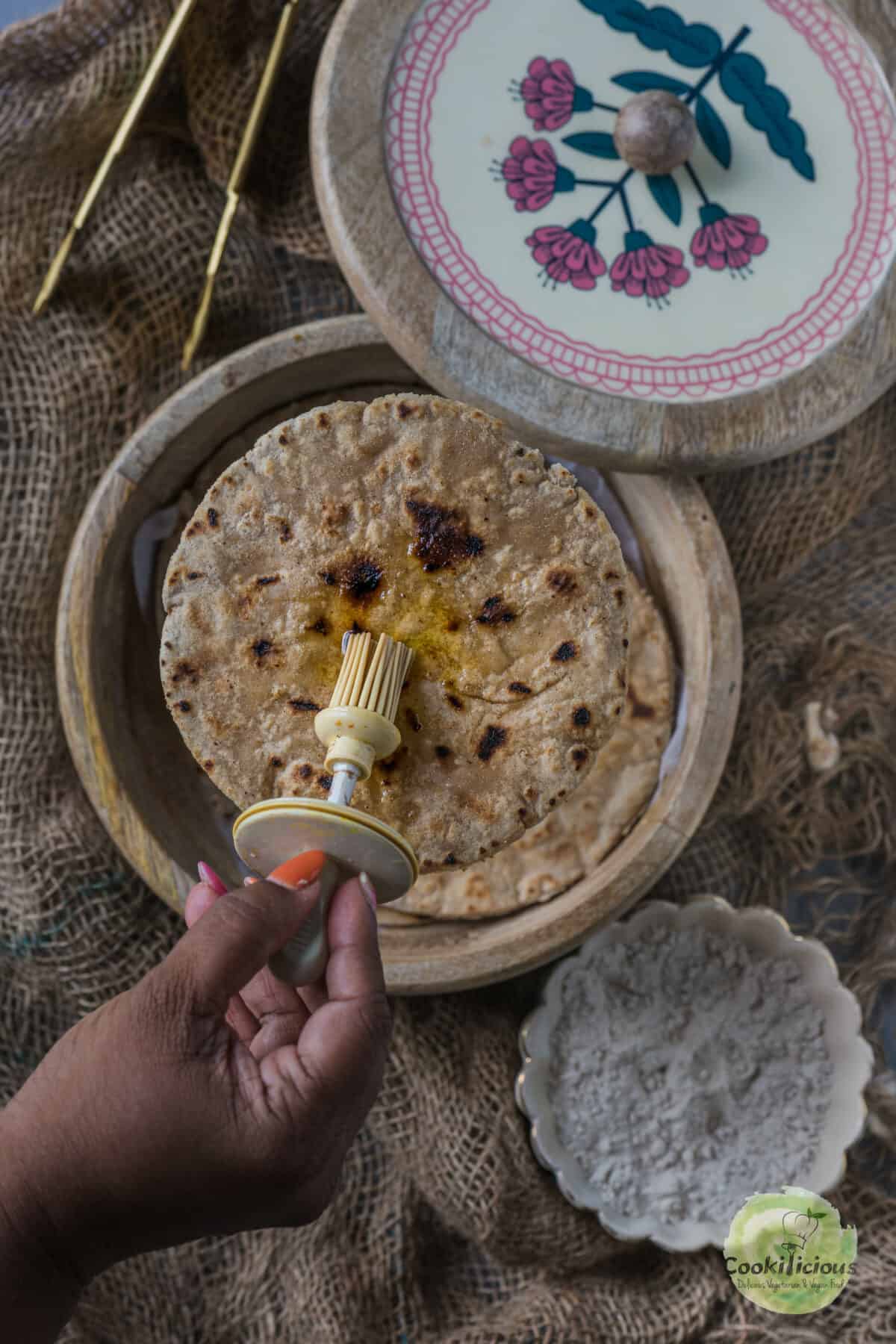
Jump to:
What is a roti
Roti is a round, flat unleavened Indian flatbread. It's high in fiber compared to other types of bread. The high fiber content keeps you satiated for longer and supports healthy digestion. Rotis are an integral part of the Indian meal and can be consumed daily. You can have 1-2 per meal and a side of vegetables. Rotis are a staple in the North and West of India, as much as rice is a staple in the South of India.
Difference between roti and chapati
The word roti and chapati are used interchangeably but they are slightly different. A roti is typically made with whole wheat flour and sometimes all-purpose flour while a chapati is made only using whole wheat flour. A chapati is soft and pliable in texture. A Roti is more rustic and thick in comparison.
Both chapatis and rotis are made without any leavening agents like yeast or baking powder and are not generally gluten-free. A roti is traditionally cooked in a tandoor while chapati is cooked on a tawa. Both the flatbreads are both naturally vegan and the dairy comes from the ghee or butter that's smeared over it.
What is gluten
Gluten is a natural protein found in wheat. It improves the texture and elasticity of the dough. Grains high in gluten content are wheat, spelt, barley, and durum wheat. Gluten is generally difficult to digest for many people. It can irritate the intestinal mucosa resulting in bloating, flatulence along with greasy and mushy stools. Vitamin and mineral deficiencies can also arise due to gluten-absorption disorders. It's said that in order to find out if you are gluten intolerant, it's best to avoid eating gluten for at least 2 months.
Gluten-free flour alternatives
Gluten-free flour or atta (in Hindi) means there is no gluten in it. Gluten-free flour does not contain wheat but is made with ingredients like grains, nuts, and seeds. Rice, teff or injera, quinoa, oats, buckwheat, nut flours, coconut flour, cassava flour, tapioca flour, lentils, chickpea flour or besan, and millets like jowar, bajra, and amaranth are gluten-free, and, therefore, great alternatives for a gluten-free diet.
There are many varieties of roti recipes in Indian cuisine that use gluten-free flour. One of the popular versions is rice flour roti (chawal ki roti) that's very popular in South Asian countries such as India, Bangladesh, and Sri Lanka. I wanted to give my readers more gluten-free roti recipe options different from the Jowar Bhakhri or Bajra Bhakhri. So I decided to make this Indian roti with rice flour and teff flour since both have neutral flavors.
Rice flour contains more carbs, so I wanted to balance it out by adding teff flour and oats. I tested many other flour combinations and tweaked the ratios before settling on this one because I wanted to ensure I gave you a foolproof recipe. This vegan roti recipe is also beginner friendly. If you have celiac disease, are gluten intolerant, are on a gluten-free journey, or want to reduce your wheat intake in the diet, then give this Indian flatbread recipe a try.
What is Teff

Teff is a naturally gluten-free, and vegan grain that looks very similar to ragi. It is also the smallest grain on earth. Teff is quick and easy to cook on the stovetop. There are many health benefits to including this millet in your diet. It's a good source of calcium, iron, manganese, magnesium, zinc, and dietary fiber. It is nutrient-dense, rich in protein, non-GMO, and glyphosate-free. In fact, teff has more essential amino acids than barley and wheat.
I love that it is effortless to cook with, greatly flavorful, and highly nutritious! If you haven't yet tried teff, then you are missing out on a healthy grain. In fact, teff (also known as Injera)is a better choice than oats or quinoa because of its numerous health benefits. I have been enjoying cooking Indian and non-Indian recipes with teff, like Teff Kheer Porridge, Banana Bread, Teff idli, Teff Patties, or Teff Masala Khichdi.
Read more about Teff on Maskal Teff's website. Maskal Teff is available in most leading grocery stores, or you can order directly from their website or Amazon. Teff or Injera comes in 4 different varieties - Brown and Ivory grain and flour. Brown has a slightly nutty flavor, and Ivory has a sweet, mild flavor. The flour can be used to bake homemade bread, cookies, or cakes and the grain can be used in cereals, soups, stews, etc.
Why make this
- It's a nut-free, vegan, and gluten-free roti/flatbread recipe
- Made with 3 basic ingredients
- No xanthan gum, yeast, or psyllium husk needed
- It's made with very little oil
- The recipe is easily scalable
- Can be made in 30 minutes
- It's healthy and nutritious
- A great way to include teff in your diet
Ingredients needed 🧾
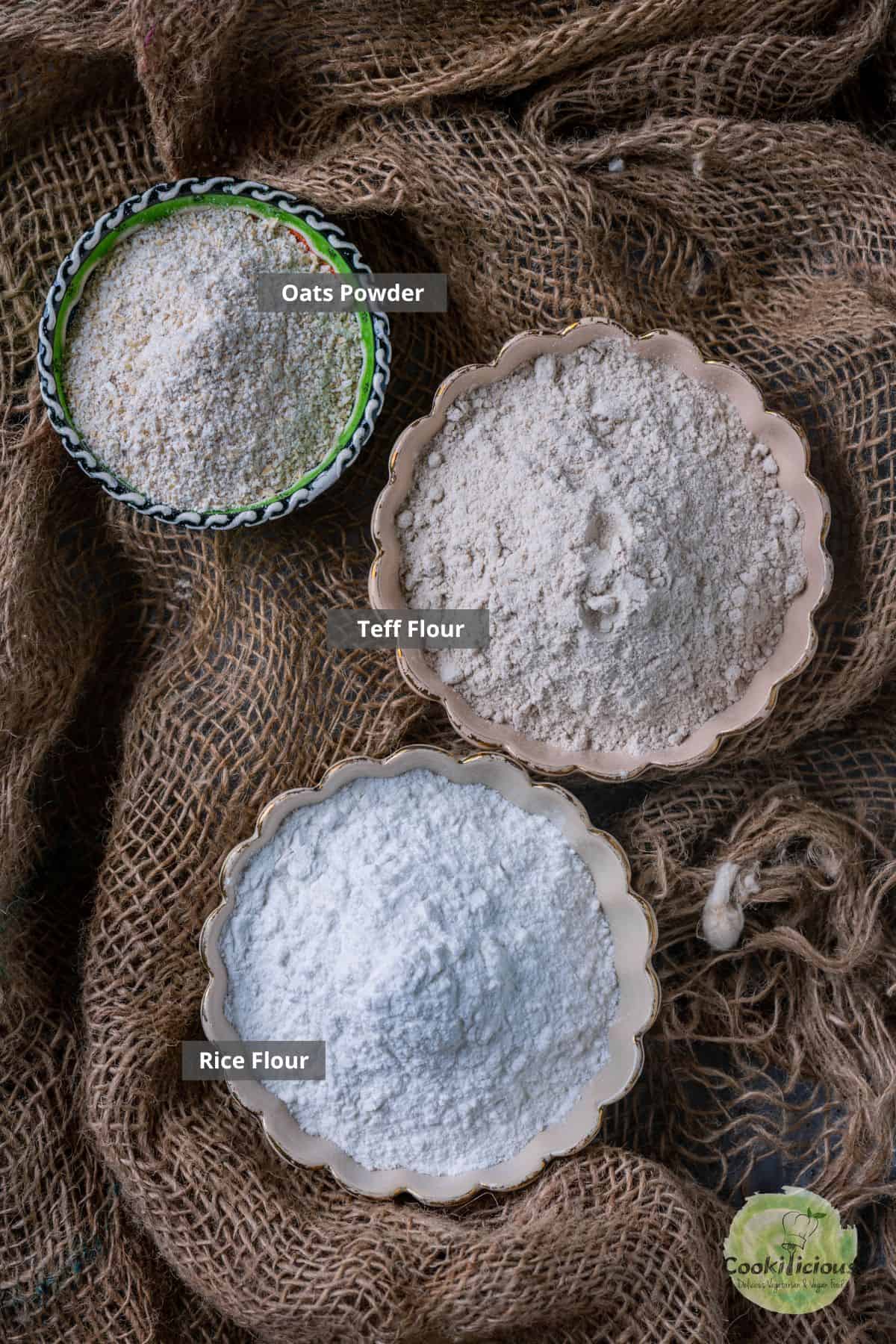
Rice flour - is a finely ground powder of de-husked rice. It is high in fiber and carbs. The natural starches in the rice will help with the binding. I have not tried brown rice flour in this recipe. But you can if you want to. I usually get rice flour from the Indian grocery store. Do not grind rice at home and use it as a substitute. It has to be rice flour. I use rice flour to make this very Indian popular snack called Methi Ghavan.
Teff flour - Use Maskal Teff Ivory or Brown teff flour in this recipe. During recipe testing, I realized that teff flour is one of the easiest alternative flours to work with. The flour is easier to knead, the chapati is comparatively easy to roll and the taste is also good.
Oats flour - Use old-fashioned rolled oats and grind them to make a fine powder. Use it as oats flour. Make sure the package says certified gluten-free rolled oats. You can also use store-bought oat flour. Oats are rich in fiber and nutrients. They also add stability to the dough while rolling out and that's why they are a great addition to this multi-flour blend roti dough.
Water, salt, and vegan ghee are other essential ingredients needed to make the millet roti dough. Instead of vegan ghee, you can also use any neutral cooking oil or vegan butter.
Besides these ingredients, you will also need a chakla and rolling pin (or a silicone mat or wooden board), tawa, and a thin flat-turner to make these gluten-free millet rotis. I like to keep the cooked chapatis warm in a roti box. Mine is from Chumbak, India but you can get one from Arjuna Studio. Use my code Cookilicious10 for 10% off if you want to support a woman-owned small business. BTW, you don't need a stand mixer to knead the dough.
How to make it 🔪
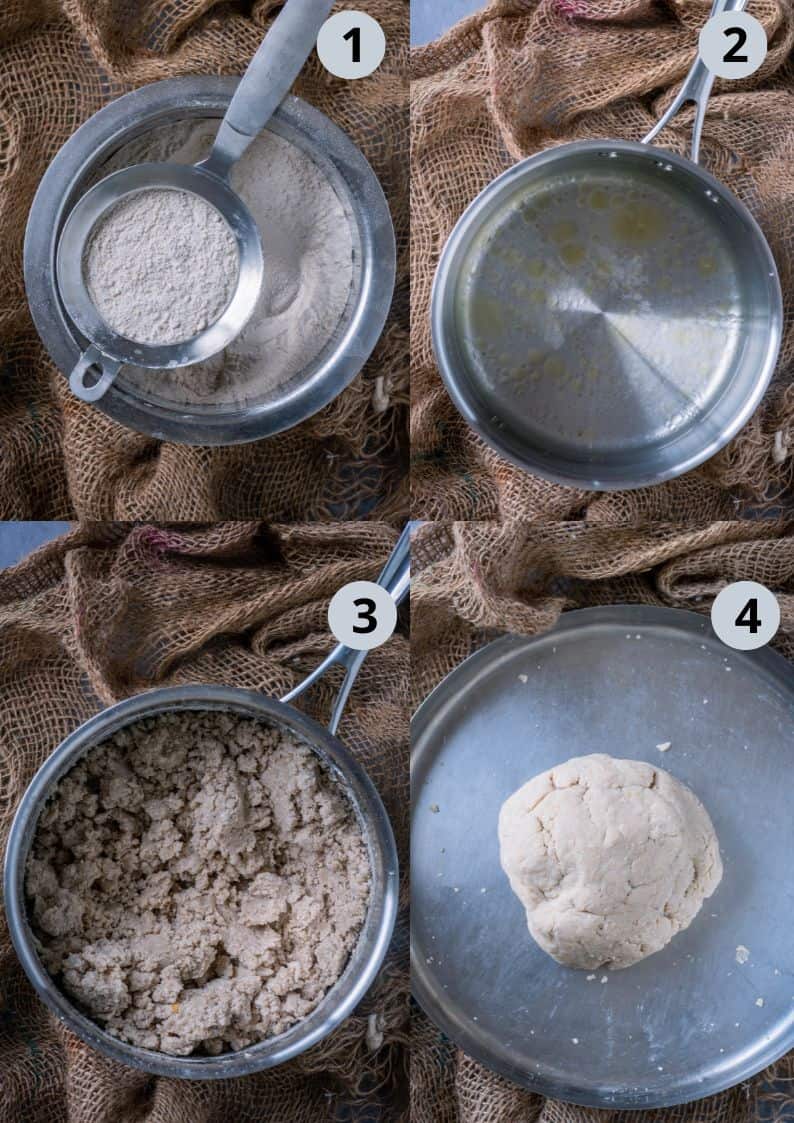
Want to save this recipe?
- Sieve the 3 flours and add them to a bowl. This step will ensure that the rotis are soft.
- Add water to a pot and bring it to a boil. Add salt and oil while the water is heating up.
- When the water is boiling, take the pot off the flame. Slowly add the sieved rice flour, teff flour, and oats powder. Chef Tip - Start mixing using a silicone spatula. Quickly mix it all together till there is no dry flour visible. Break the clumps as much as you can. Cover with a lid and let it sit for 10 minutes. It will resemble a crumbly dough.
- Transfer to a plate and let it cool down a bit. Wet your fingers with water and knead to make a smooth dough. If the dough appears to be dry, then sprinkle some water and with wet hands knead it again. You can also add a little oil. The roti dough needs to be slightly sticky. Chef Tip - It’s much easier to knead the dough when it's still a little hot. Just cool it enough to handle the dough comfortably. Use a spatula to knead if needed. Cover with a damp cloth or a cling wrap to prevent it from drying.
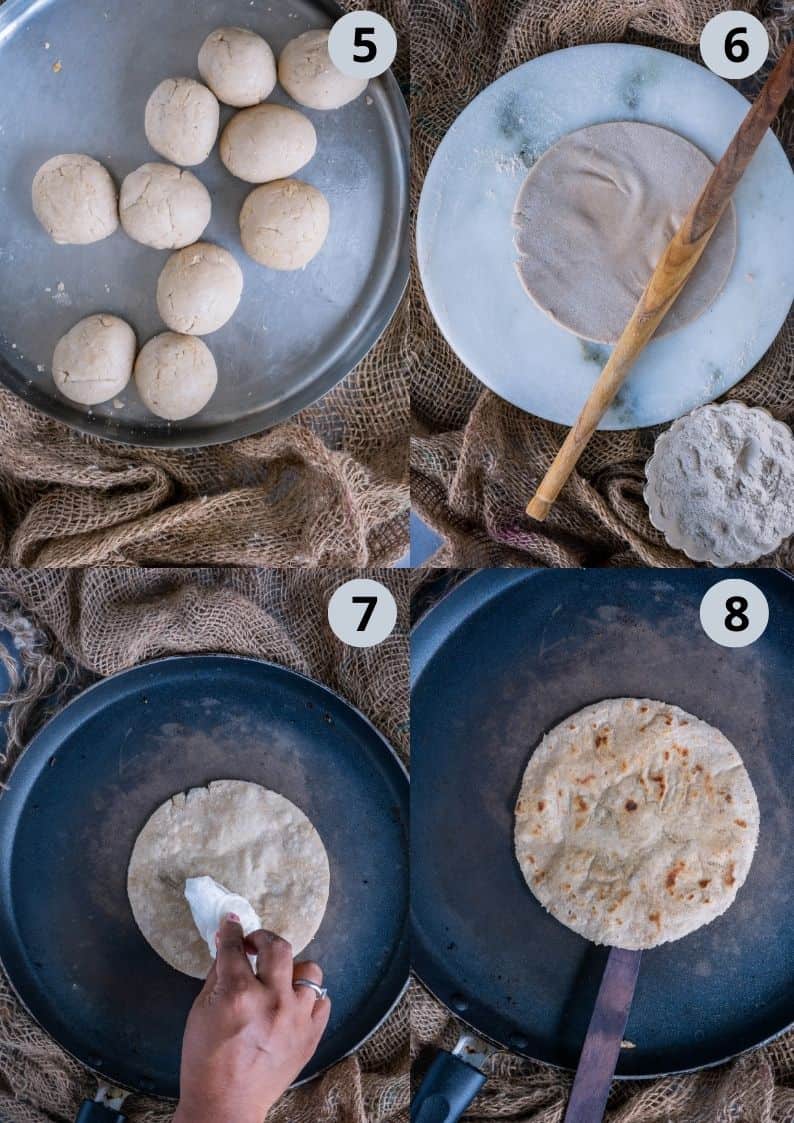
- Divide the dough into equal lemon-sized balls (about 46-48 gms each). Keep them covered with a moist towel.
- Heat a skillet or Tawa. Keep the flame on medium. Knead each ball again (to activate the starch in the dough), dip the ball in a bowl of teff flour, and flatten it with your palm. Dust the chakla or surface with flour. Using a rolling pin, roll the ball swerving it at the same time, then throw more teff flour on the top and continue to flatten the ball, constantly turning and flouring, (just like we make normal chapatis) into a flat round shape (about 5-6 inches in diameter). Chef tip - While rolling, keep sprinkling flour to prevent the roti from sticking at the bottom. You can also use your fingers to flatten it. Be careful not to break the roti. Try to flatten the roti evenly, especially the edges. Since the dough is gluten-free it’s hard to get smooth edges, so to get a neat round shape, use a cutter or any bowl.
- Carefully transfer the uncooked roti to the tawa. Make sure the tawa is not extremely hot. Using a damp paper towel, press the roti lightly to soak up the excess flour on both sides. Once tiny bubbles begin to appear on the initial side, it is time to flip the roti.
- Cook the other side till small light brown spots appear on them. Flip it again. Press the edges of the roti around using the turner, this helps it puff. Each roti will take 2-3 minutes to fully cook. Transfer to a plate. Smear each side with vegan ghee. Prepare the remaining rotis the same way. Keep the cooked teff rotis in a roti box till it's time to serve them.
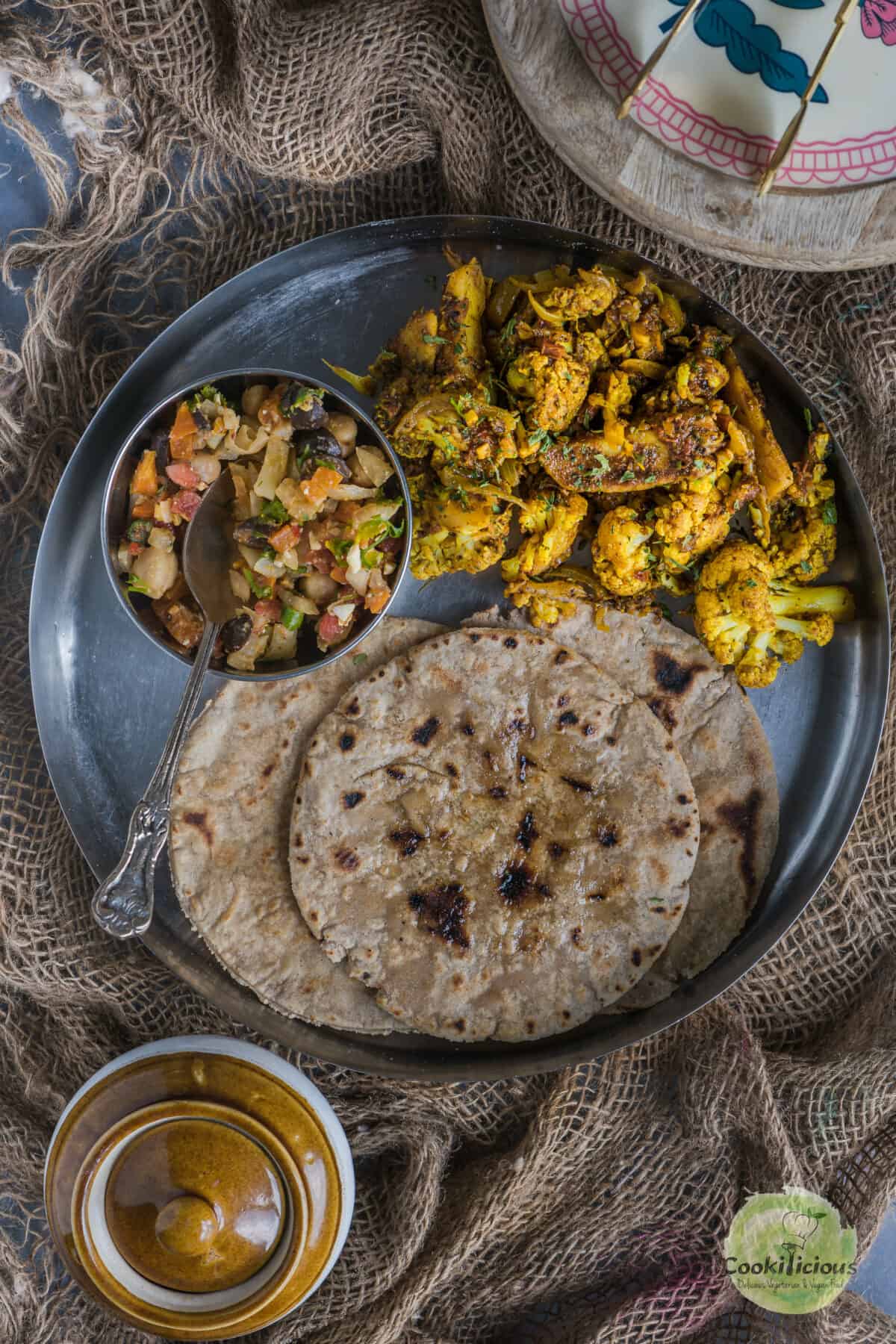
Serving suggestions 🍽
It's best to make and serve this Teff and Rice roti warm and fresh because they can harden later if not stored properly. Nothing beats the flavor of freshly made homemade rotis. Now you can also enjoy rotis without gluten. This easy gluten-free flatbread can be served instead of regular roti, chapati, naan, kulcha, or paratha. They can also be served as tostadas, pita bread, fajitas, a pizza base, and tortillas.
What pairs well with gluten-free roti
Serve it as a side for dipping or scooping in any stir-fries, and Indian curries like Aloo Gobi, Jalfrezi, Aloo Matar, Mushroom Stir-Fry, Tofu Tikka Masala, Methi Matar Malai, Dum Aloo, Khoya Matar, Kadai Paneer, Bhindi Masala, Aloo Bharta, or Aloo Methi. It also pairs well with any Indian Dals like Sultani Dal, Shahjahani Dal, Dal Tadka, or Methi Dal and even with Dal Soup. Some alternate ways of serving these homemade millet rotis are with hummus, raita, pesto, Bombay chutney, Indian pickle, Thecha, or chutney. Make them a staple in your homes.
If the teff roti goes hard when cool and can’t be softened, you can serve them as crackers! Bake them at 350 degrees F for about 6-8 minutes or until crisp. Brush it with a bit of chili oil for flavor. Yum!
Top recipe tips 💭
Oats flour is optional. You can skip it if you want. Flax meal or chickpea flour can be used instead. Use the same measuring cup to measure all the ingredients. Once the dough is prepared, cover it with a moist towel to prevent it from drying. The roti should not be rolled out too thin or too thick. Greasing your palms before kneading helps. The tawa needs to be hot but not too hot or too low. The recipe is easily scalable.
Making this roti dough and these rotis require a bit of practice. Do not get discouraged if they don't turn out right on the first attempt. I have been following this recipe for months now. It works. Be patient and try to follow the recipe using my tips. The process is a bit messy since we are working with dry flour. So be ready for some cleanup later. Also, these rotis are not very soft like a traditional roti or chapati because it does not contain gluten.
Recipe FAQs 📖
It's done to achieve starch gelatinization. Scientifically speaking, water and starch are heated up to the point that the starch molecules swell up allowing the water to absorb more fully into the starch. Mixing the dough in hot water and then letting it rest for a couple of minutes gives the millet flour an opportunity to hydrate. Steaming the dough this way makes it easier to roll out the gluten-free roti and also makes the finished roti more soft and pliable.
To make it more flavorful, add chopped cilantro, ginger-garlic paste, green chillies, and fresh greens like methi or spinach to the boiling water. You can also add spices like cumin seeds, Kasoori methi, turmeric powder, coriander powder, cumin powder, garlic powder, onion powder, dried herbs, and garam masala to the water. Crumbed paneer, chopped onions, or mashed potato can also be mixed into the dough. To make fluffier roti, add a teaspoon of baking powder and baking soda. This will make the rotis stay softer for longer.
If you cannot shape the dough into balls or the roti keeps breaking when rolling, it means the dough is dry. Sprinkle some water and with wet hands knead it again. It will appear sticky in the beginning but will then form into a dough. Be careful when adding water. Add a little at a time. Also, if the dough is very sticky then add some flour.
You can place the dough ball in between a parchment paper and use a rolling pin or a tortilla press to press it. The other alternative is to cut open a quart-size ziplock bag and use that instead of parchment paper.
Once the roti is cooked on the tawa, transfer it directly to an open flame or a wire rack on the flame, using tongs, and cook both sides till it's slightly charred and the roti puffs up. Try this method once you have practiced making these rotis a couple of times.
Yes, you can. I would suggest you divide the dough into balls and then place a moist paper towel on them and store them in an airtight container to retain the moisture. It stays well for 1-2 days. Let it come to room temperature and then knead it again with a wet palm before making rotis.
To freeze - place parchment paper between each (uncooked) rolled-out roti in order to prevent them from sticking. Then place them in a ziplock bag.
Leftover cooked rotis can be stored in the fridge for 1-2 days. Reheat and serve. They will harden though. These gluten-free rice flatbreads taste best when served fresh.
Unusual curries of India
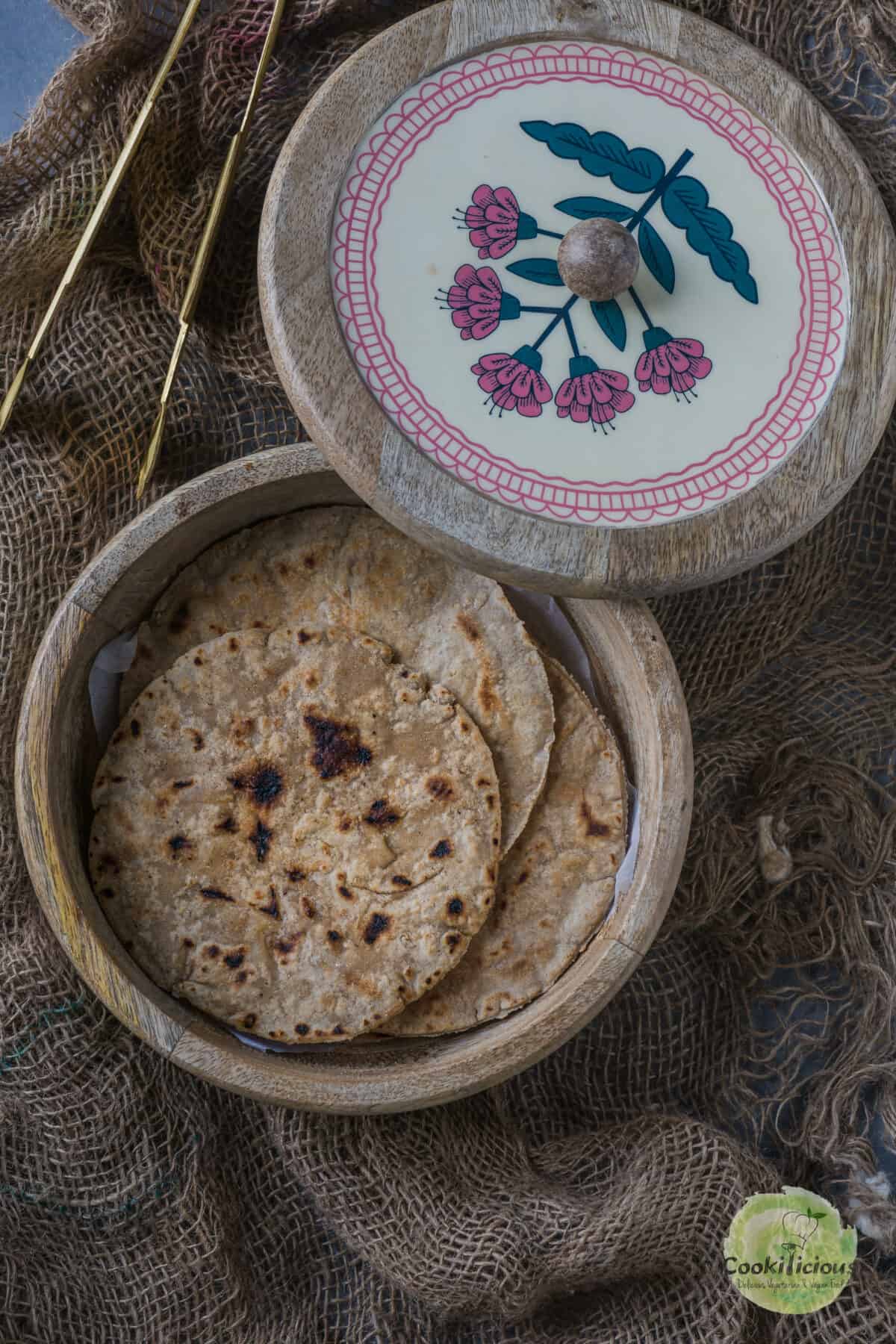
Recipe 📖
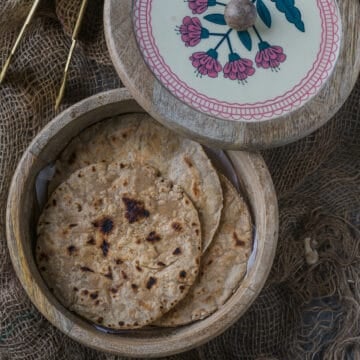
Roti Recipe | Gluten-Free Flatbread
Equipment
Ingredients
- 1 cup water
- ½ cup teff flour
- ½ cup rice flour
- 2 tablespoon oats powder
- 1 teaspoon vegan ghee or oil
- ½ teaspoon salt
Instructions
- Sieve the 3 flours and add them to a bowl. This step will ensure that the rotis are soft.
- Add the water to a pot and bring it to a boil. Add salt and oil while the water is heating up.
- When the water is boiling, take the pot off the flame. Slowly add the sieved rice flour, teff flour, and oats powder. Chef Tip - Start mixing using a silicone spatula. Quickly mix it all together till there is no dry flour visible. Break the clumps as much as you can. Cover with a lid and let it sit for 10 minutes. It will resemble a crumbly dough.
- Transfer to a plate and let it cool down a bit. Wet your fingers with water and knead to make a smooth dough. If the dough appears to be dry, then sprinkle some water and with wet hands knead it again. You can also add little oil. The roti dough needs to be slightly sticky. Chef Tip - It’s much easier to knead the dough when it's still a little hot. Just cool it enough to handle the dough comfortably. Use a spatula to knead if needed. Cover with a damp cloth or a cling wrap to prevent it from drying.
- Divide the dough into equal lemon-sized balls (about 46-48 gms each). Keep them covered with a moist towel.
- Heat a skillet or Tawa over a medium flame. Knead each ball again (to activate the starch in the dough), dip the ball in a bowl of teff flour, and flatten it with your palm. Dust the chakla or surface with flour. Using a rolling pin, roll the ball swerving it at the same time, then throw more teff flour on the top and continue to flatten the ball, constantly turning and flouring, (just like we make normal chapattis) into a flat round shape (about 5-6 inches in diameter). Chef tip - While rolling, keep sprinkling flour to prevent the roti from sticking at the bottom. You can also use your fingers to flatten it. Be careful not to break the roti. Try to flatten the roti evenly, especially the edges. Since the dough is gluten-free it’s hard to get smooth edges, so to get a neat round shape, use a cutter or any bowl.
- Carefully transfer the uncooked roti to the tawa. Make sure the tawa is not extremely hot. Using a damp paper towel, press the roti lightly to soak up the excess flour on both sides. Once tiny bubbles begin to appear on the initial side, it is time to flip the roti.
- Cook the other side till small light brown spots appear on them. Flip it again. Press the edges of the roti around using the turner, this helps it puff. Each roti will take 2-3 minutes to fully cook. Transfer to a plate. Smear each side with vegan ghee. Prepare the remaining rotis the same way. Keep the cooked teff rotis in a roti box till it's time to serve them.

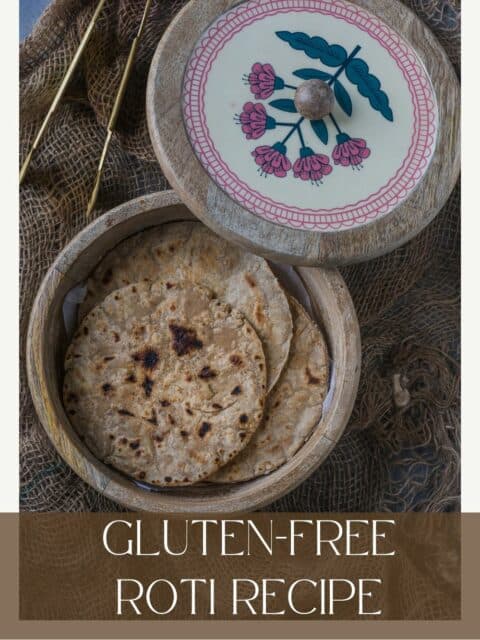
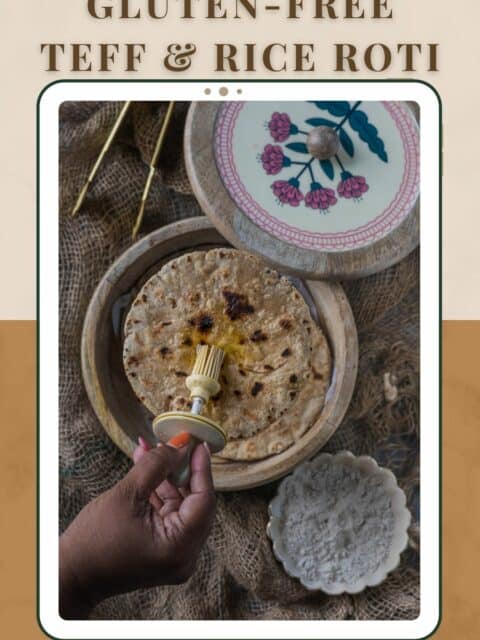


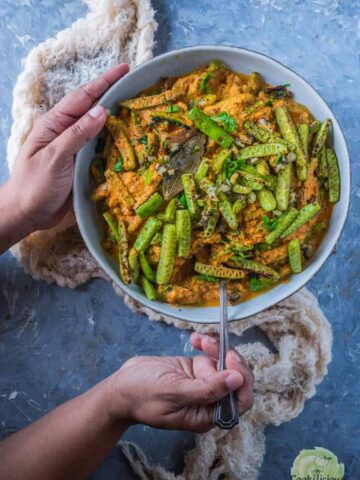
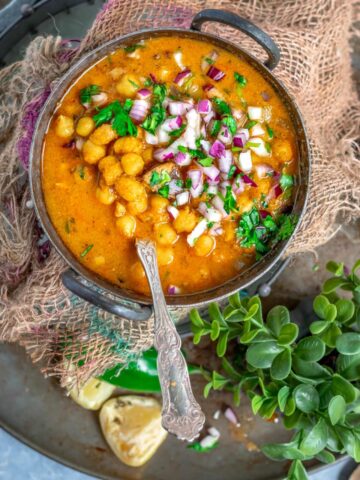
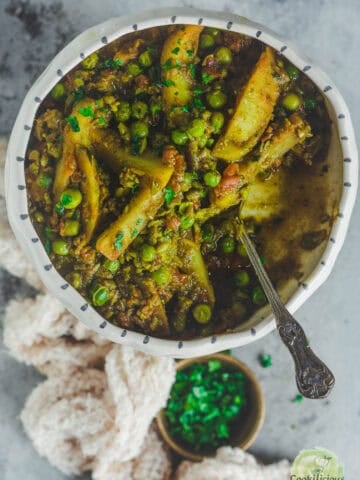
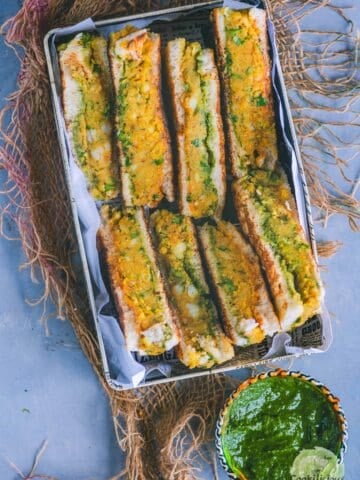
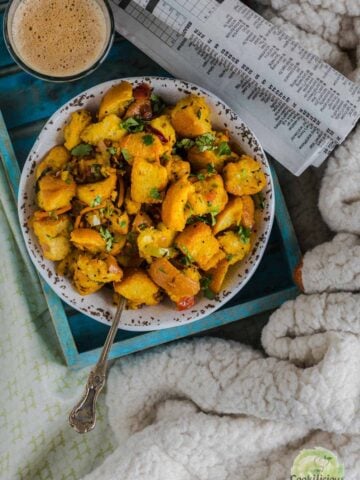

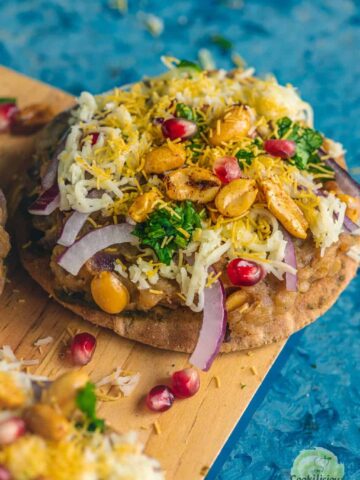
Leave a Reply